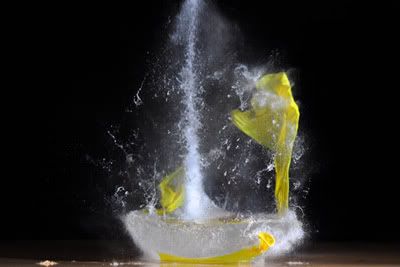Disclaimer : This theory is made up based on my studies of TTL/BL and is not information from Nikon themselves .... but I still think it may be the truth .
This may be the most simple fact of TTL/BL - or just my wild speculation , but the easiest way to understand the fact that TTL/BL has a similar consistency to matrix metering is to think of it as the same program in that it can 'map out' its subject based on colour information [and the pre-flash reading] .
How can TTL/BL have greater consistency regardless of subject size unless it is totally independent of subject size ?
I'll start off with a simple subject with a dark background .
Whether we have the subject under-exposed or correctly exposed TTL sees this : The area it meters off - end of story .
TTL/BL sees the subject based on the matrix metering pattern which is what gives it the edge with reflective subjects [ more on that later ] .
TTL needs to get an average gray in the centre of the frame and fires stronger when the subject does not fill the frame ....
to get this result .. [ average filter applied to centre of frame ]
TTL/BL on the other hand fires a pre-flash [ as does TTL ] and 'maps out ' its subject based on the reading it receives ....
It uses the 'focus point diamond' to determine where its subject is and 'maps it out' rather than relying on it being a certain size .
And gives a much better exposure ....
Then we move the subject off-centre and see what TTL does to get an average gray in the centre of the frame ....
TTL flash still only sees the centre of the frame and has to totally over-expose the subject to get its average gray in the centre circle ...
Now here's how I define TTL/BL metering , if the subject is off centre it is still using the focus point diamond to 'find' its subject and 'map it out ' and so maintains consistency with its output .
When it did its pre-flash it mapped out the subject using the matrix metering pattern and was not fooled by the off-centre subject [ which is why you don't need to use 'fv-lock' with TTL/BL ] .
Here's another two samples with the subject below the centre of the frame .... TTL :
TTL/BL :
I can think of no possible scenario where TTL will beat TTL/BL with direct flash [ which you would mostly use outdoors ] . In brighter light [ with the ambient closer to correct exposure ] TTL/BL will back off accordingly while TTL will fire at exactly the same power it has here .
On to the 'reflections' ... This is just theory based on some 'borrowed' information from the Canon E-TTL system . The Nikon manual mentions that TTL/BL is good for reflective surfaces but doesn't explain why . Obviously we can't simply assume that Canon and Nikon flash works the same way but much of E-TTL appears to work the same as TTL/BL and it is a useful explanation with regard to E-TTL which mentions that " E-TTL II examines all evaluative metering zones both before and after the E-TTL preflash goes off. Those areas with relatively small changes in brightness are then weighted for flash metering. This is done to avoid the common E-TTL problem of highly reflective materials causing specular highlights in a flash-illuminated image and throwing off the flash metering. ". As mentioned we can't 'assume' that TTL/BL and E-TTL work exactly the same way but it's a highly likely possibility .
If it does work the same way then my understanding of this is that TTL/BL can analyze the matrix metering pattern before the flash fires ....
And then when it fires the pre-flash it can trace out the subject and pick up the reflections and reject them from the metering equation ...
This may also be why TTL/BL doesn't work when you switch to spot metering . It needs the whole pattern to be active to do its calculations . Changing to spot metering 'switches off' the rest of the metering pattern and so TTL/BL can't do its calculations unless you are in centre weighted or matrix metering - because then the whole pattern is available for its use .


















No comments:
Post a Comment